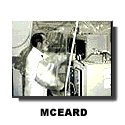|
 |
 |
Microbiological
and Chemical Exposure Assessment Research Division

Welcome to the Microbiological and Chemical Exposure Assessment Research
Division (MCEARD) Home Page. This Division was formerly known as the
Human Exposure Research Division (HERD). It is a division of the National
Exposure Research Laboratory (NERL)
and operates within the Office of Research and Development (ORD).
MCEARD conducts research to measure, characterize and predict the exposure
of humans to chemical and microbial hazards. This research will provide
information on environmental pathways which hazardous contaminants are
transported via air, water, food, and soil to populations at risk. Analytical
quantitative methods are developed to accurately and specifically measure
human risk factors associated with inhalation, ingestion and dermal pathways.
Surveys and monitoring studies are carried out to determine the levels
of hazardous chemicals and microbials in environmental matrices, and human
populations are studied to determine significant exposure pathways, the
levels of exposure, and the sources of exposure factors. State-of-the-art
analytical methods are used to measure organic and inorganic chemicals.
Genomic and immuno-based methods, as well traditional cultural methods,
are used to measure hazardous bacteria, viruses, fungi, and protozoa.
Molecular- and sero-epidemiological tools are used to assess human populations
for evidence of exposure to environmental hazards. The Division conducts
its multidiscipline research program with a broad skill mix of scientists
that includes organic, inorganic, and analytical chemists, bacteriologists,
virologists, parasitologists, immunologists, and molecular biologists.
The Division is one of several U.S. EPA research organizations located
in the Andrew W. Breidenbach Environmental Research Center
at 26 West M.L. King Drive, Cincinnati, Ohio, 45268 . This Center is in
the Clifton/Corryville area just north of downtown Cincinnati and is located
between interstates I-75 and I-71. It is situated adjacent to the main
campus of the University of Cincinnati. The Division consists of three
branches, the Biohazard Assessment Research Branch,
the Microbial Exposure Research Branch, and the
Chemical Exposure Research Branch.
| MCEARD Online Methods: These methods
were developed with MCEARD support and are made available in
Adobe Acrobat ® PDF format. |
|
|
| MCEARD Publication List: Citations
for MCEARD research publications (including posters and presentations)
in PDF format. |
|
|
MCEARD Featured Activity:
The NEEAR Water Study
is a multi-year research project evaluating the health effects
of persons using recreational waters. The study is a collaborative
effort between NERL and the National Health & Environmental
Effects Research Laboratory. Within NERL, the Microbiological
and Chemical Exposure Assessment Research Division is responsible
for the Water Quality component of this study. |
|
MCEARD Director (Acting):
Dr. Larry T. Cupitt |
|
MCEARD Associate Director:
Mr. James Owens |
|
Note: Adobe Acrobat Reader is
required to view PDF documents. The most recent version of the Adobe
Acrobat Reader  is available as a free download. An Adobe
Acrobat plug-in for assisted technologies is also available.
is available as a free download. An Adobe
Acrobat plug-in for assisted technologies is also available. |
|

